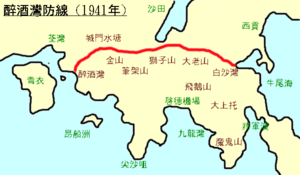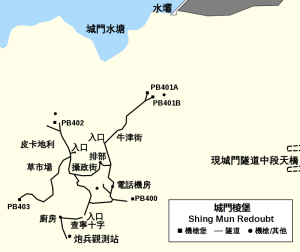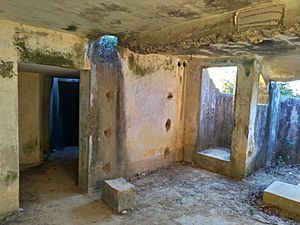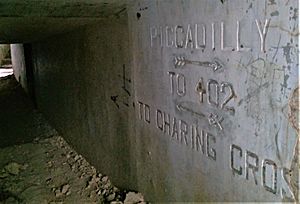Gin Drinkers Line facts for kids
Quick facts for kids Gin Drinkers Line |
|
|---|---|
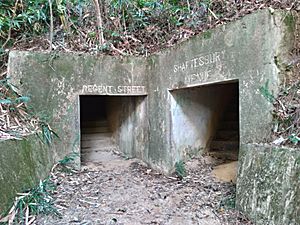
The "Regent Street" and "Shaftesbury Avenue" entrances on the Shing Mun Redoubt ("Strand Palace Hotel")
|
|
| Traditional Chinese | 醉酒灣防線 |
| Simplified Chinese | 醉酒湾防线 |
| Hanyu Pinyin | Zuìjiǔ wān fángxiàn |
| Wade–Giles | Tsui-chiu wan fang-hsien |
| IPA | [tsu̯êi̯tɕi̯òu̯ u̯án fǎŋɕi̯ɛ̂n] |
| Yale Romanization | Jeuijáu wāan fòhngsin |
| IPA | [tsɵ̄ytsɐ̌u wáːn fɔ̏ːŋsɪ̄n] |
| Jyutping | Zeoi3zau2 waan1 fong4sin3 |
The Gin Drinkers Line was a special defensive line built by the British army in Hong Kong. It was meant to protect Hong Kong from a Japanese invasion during World War II. This happened in December 1941, as part of the Pacific War.
The idea for this line came from France's Maginot Line, a strong defense built after World War I. The British thought their line could stop the Japanese for at least six months. They even called it the "Oriental Maginot Line." However, Japanese generals soon found out the line was not as strong as it seemed. For example, only 30 soldiers were defending a key part called the Shing Mun Redoubt during the Battle of Hong Kong. This area could hold 120 soldiers.
Contents
Where Was the Gin Drinkers Line?
The line got its name from Gin Drinkers Bay. This was a bay near Kwai Chung in the New Territories. Today, that area has been filled in and is part of Kwai Fong.
The Gin Drinkers Line stretched across many important places. It went through Kam Shan, the Shing Mun Reservoir, Beacon Hill, Lion Rock, and Tate's Cairn. It ended at Port Shelter in Sai Kung District. The whole line was about 18 kilometers long.
The most important parts of the line were between Beacon Hill and Sha Tin Pass, and the Shing Mun Redoubt. The Shing Mun Redoubt was also where the main command center for the line was located.
This defensive line used the mountains north of the Kowloon Peninsula. This was a smart move to stop any army from invading Hong Kong from the north.
Many entrances and passages along the line were named after famous streets in Central London. You could find names like "Oxford Street," "Regent Street," and "Charing Cross" written above them. The Shing Mun Redoubt even had a secret nickname: the "Strand Palace Hotel."
How Was the Line Built?
Construction of the Gin Drinkers Line took place from 1936 to 1938. It wasn't one long, solid wall. Instead, it was a series of strong defensive spots connected by paths.
Along the line, the British built many important structures:
- Bunkers: Strong underground shelters.
- Machine gun posts: Concrete spots for machine guns.
- Trenches: Long, deep ditches for soldiers to hide in.
- Artillery batteries: Places for big guns.
However, some people believe there weren't enough big guns to support the line properly.
The Shing Mun Redoubt
The main defensive headquarters was at the Shing Mun Redoubt. This place was also known as the "Strand Palace Hotel." It had a special observation post. From here, soldiers could call for artillery support from big guns located far away, like at Mount Davis and Stonecutters Island Fort.
The redoubt also had four small forts called pillboxes (PB400-403). These were fitted with powerful Vickers machine guns and Bren LMGs. The redoubt was built on the northern slopes of Smuggler’s Ridge. There were also deep defensive channels, or trenches, about 1.5 meters deep. These trenches were named after London roads like Charing Cross and helped protect the British soldiers.
The Battle for Hong Kong
December 8, 1941: First Contact
On the morning of December 8, 1941, Japanese planes bombed Kai Tak Airport. This gave them control of the sky and started the Battle of Hong Kong. At noon, Japanese soldiers crossed the Shenzhen River and invaded the New Territories.
The British soldiers in the north quickly moved back to the Gin Drinkers Line. They destroyed roads and bridges as they went to slow down the Japanese. By evening, the Japanese had taken Tai Po.
Only three British army groups were defending the Gin Drinkers Line:
- The 2nd Battalion, Royal Scots in the west.
- The 2/14th Battalion, Punjab Regiment in the middle.
- The 5/7th Battalion, Rajput Regiment in the east.
The British hoped these soldiers could hold the line for at least three weeks and cause many problems for the Japanese.
December 9: Japanese Surprise Attack
On December 9, Japanese scouts found a weak spot in the British defenses. This was at "225 High Ground" near the Shing Mun Redoubt and Shing Mun Reservoir. This high ground was important because it overlooked all the western parts of the line. So, the Japanese planned a surprise attack.
At 9:00 PM that night, a Japanese lieutenant and ten skilled soldiers began their secret attack. Their engineers managed to cut through the barbed wire and destroy the bunkers. By 7:00 AM on December 10, they had taken the high ground and captured 27 British soldiers. This created a big hole in the Gin Drinkers Line.
The Japanese commanders were very surprised by this quick success. They had thought it would take at least a month to break the British defenses. Because of this, they sent more soldiers from mainland China to help. Even though they worried about their supplies keeping up, they decided to launch a full attack.
December 10: Full Attack
Japanese forces then attacked the Gin Drinkers Line from two sides. By the next day, they had already captured Kam Shan and Tate's Cairn. Major General Christopher Maltby, the British commander, knew they could not hold the line any longer. At noon, he decided to move his soldiers back to Hong Kong Island to save their strength. This meant the Gin Drinkers Line had fallen.
Soldiers on the western side of the line started retreating to the island at 8:00 PM. The Rajput Battalion stayed behind to protect the retreat. They only left on the morning of December 13, moving towards Devil's Peak and Lei Yue Mun before crossing to Hong Kong Island. This was the last time British forces left the Kowloon Peninsula. In the end, out of 43 men at the Shing Mun Redoubt, 3 were killed, 27 were captured, and 13 managed to escape.
Why Did the Line Fail?
The Gin Drinkers Line is seen as a big failure. The British army gave up the line and all of Kowloon in just two days. There were two main reasons for this:
- Not enough soldiers: The British had good weapons, but they didn't have enough soldiers to use the line's full potential. For example, the Shing Mun Redoubt could hold over 120 soldiers, but only 43 were there. Many soldiers were sick with malaria because there were a lot of mosquitoes in that area.
- Underestimating the Japanese: The British thought the Japanese didn't fight at night, so they were less careful. They also believed too much in their line's strength and thought they could easily push the Japanese back.
The Gin Drinkers Line Today
Remains of the Line
Most of the Shing Mun Redoubt's structures can still be found today. However, many other parts of the Gin Drinkers Line are gone. The defensive buildings left at Shing Mun Redoubt, and the pillboxes at Lion Rock, Tate's Cairn, and Port Shelter, have been damaged. This damage was caused by gunshots and grenades during the battle. These old military sites are not kept up and can be dangerous to enter.
Nature Around the Line
When the Gin Drinkers Line was first built, the land around it was quite bare. But since it was abandoned, many young trees have grown there. Now, the area is much greener and full of nature.
See Also
- Japanese occupation of Hong Kong
- Battle of Hong Kong
- Eight Mountains of Kowloon


